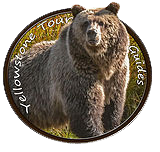For decades people have visited Yellowstone National Park to get up close and personal with nature and the amazing wildlife that lives there. Guided Yellowstone tours are one of the best ways to see the park. With a trained tour guide, you can be sure that you will not miss any of the exciting aspects of this amazing place.
Recently, backpackers enjoying Yellowstone were treated to a rare encounter. While backpacking through the Teton wilderness, Yellowstone naturalist guide Doug MacCartney witnessed what many experts believed to be an unusual phenomenon. Recorded on film, MacCartney witnessed a large gathering of wolverines chasing grizzlies across the snow.
Mr. MacCartney admits that it is already a rare thing to see wolverines at all, but images of the event recorded about 13 wolverines congregated in the high alpine. It was obvious that they were foraging for food.
When grizzlies entered the area, MacCartney was then given the show of a lifetime, as the wolverines commenced chasing the grizzlies.
Mr. MacCartney was not alone during this interesting experience in Yellowstone as he had two companions with him. The backpackers were hiking toward a particular peak, which was their goal for the day. While transversing a bowl on the summit’s western side, an area that was almost flat, they noticed a mother grizzly with two cubs. They were far enough away to safely continue hiking, while carefully watching the bears’ movements from a distance.
The hikers then noticed that the bears had started running. They stopped to see why and that was when they could see a wolverine. The animal was moving off of a big rock and going straight in the bears’ direction. To their great surprise, they saw another wolverine and another headed after the bears. All three men witnessed this unusual occurrence.
Soon there were too many wolverines to easily keep track of, but the men claim it was at least 13. They observed the wolverines split up into two groups to more effectively chase the grizzlies out of the area.
Several experts were consulted following this encounter. After reviewing the photos that were taken, some experts believe that the animals clashed in this way in competition for food in the area. There were likely animal carcasses nearby that the wolverines had already claimed. This in and of itself is not unusual, but what was unusual was the fact that the wolverines were congregated.
Generally, wolverines do not behave this way, and they do not work together to protect food or to fight off invaders.
This could be a result of animal behavior evolving as space and resources become scarce.
Yellowstone National Park is full of amazing animal encounters and guided tours are one of the best ways to experience these marvels of nature.
Many people pass up on vacation travels during winter because they think it’s not a good time to be out and about. Apart from the discomfort of the cold and the hazards of being out in the snow, it’s also mistakenly believed that there really is nothing much to see anyway.
Well, that can’t be any farther from the truth. Especially not with the fun adventures offered by Yellowstone Winter Tours. From bison and elk sightings to bighorn sheep, and even wolves, there’s still plenty to see and do in winter at Yellowstone.
If you’re looking forward to going on an adventure during winter, there’s no better place to do so than Yellowstone. Here are some of the best places you can check out for your winter wonderland experience.
Yellowstone Lake
Yellowstone Lake would be frozen around this time, but there would certainly still be open pockets where you view otters coming in and out of the freezing cold waters.
Other wildlife that could be found lingering around the area during this season are bighorn sheep, antelopes, and coyotes.
Lamar Valley
The coyotes sure do wander freely throughout the park as they can also be found over the Lamar Valley in the winter. This is because the valley becomes a perfect spot for foraging and hunting food for them and other animals like mule deer and bison.
For the most part, however, Lamar Valley is more popularly known as the wolves’ turf, so if you’re eager to see them in their natural habitat, this would be a good place to go.
Firehole River & Madison River
Over at the Firehole River and Madison River, sightseers can look forward to witnessing a variety of wildlife while sitting inside a warm, cozy coach. Bison, elk, bobcats, as well as small songbirds, and trumpeter swans head to the rivers for winter sustenance.
The Northern Range
The Northern Range in Yellowstone offers plenty of activities to do in the wildlife in winter, such as snowmobiling, dog sledding, and ice fishing. Aside from that, it’s also a great place to find foxes, bison, elk, and moose, as well as dozens of interesting owl species.
There’s also the Grizzly & Wolf Discovery Center, although the grizzlies will be in hibernation during this season.
Old Faithful
The Old Faithful area offers plenty of treats, from the most famous geyser to the herd of bison known to hang out nearby. There’s also a snowshoe tour that happens in the area that taps into the backcountry of Yellowstone.
These are but some great wildlife sights and activities you can look forward to in Yellowstone during winter. Find the right winter wildlife adventure for you and your family with Yellowstone Wildlife Tours.
